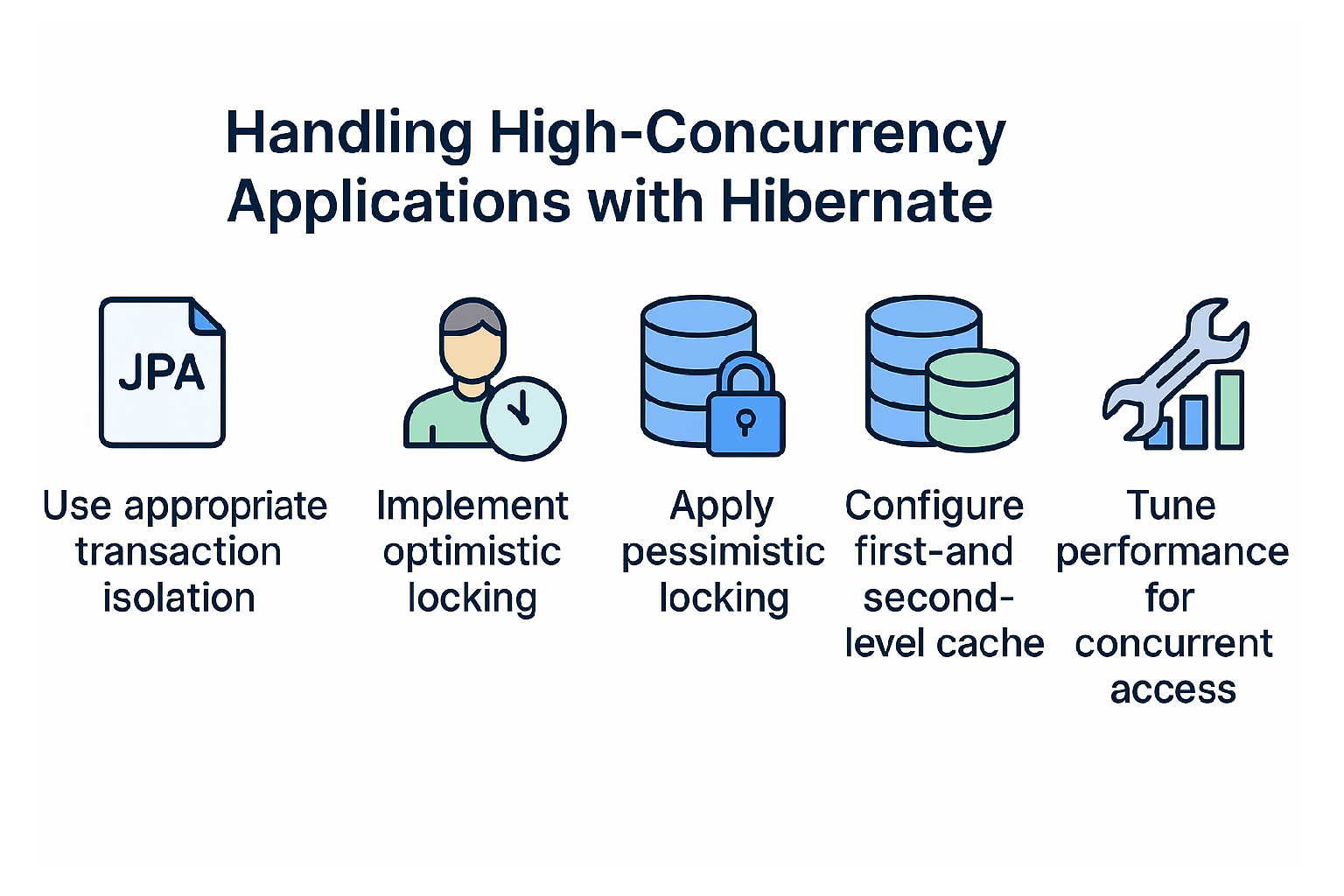Modern enterprise applications often need to handle thousands of concurrent users. In such high-concurrency environments, ensuring data consistency, performance, and scalability is critical. Hibernate, as a robust ORM framework, provides several concurrency control mechanisms that help developers manage simultaneous transactions safely and efficiently.
This tutorial explores optimistic and pessimistic locking, caching strategies, transaction isolation levels, and practical Hibernate configurations to build highly concurrent applications.
Understanding Concurrency in Hibernate
Concurrency issues occur when multiple users or processes attempt to modify the same data simultaneously. Without proper handling, this leads to:
- Dirty Reads: Reading uncommitted data.
- Non-Repeatable Reads: Data changes between two reads.
- Phantom Reads: New rows appearing in subsequent reads.
- Lost Updates: Overwriting updates from concurrent transactions.
Analogy: Imagine two people editing the same Google Doc at once. Without proper version control, one person’s changes could overwrite the other’s.
Transaction Isolation Levels
Hibernate relies on the underlying database for transaction isolation. Common levels:
- READ UNCOMMITTED – Allows dirty reads (not recommended).
- READ COMMITTED – Prevents dirty reads (default in many databases).
- REPEATABLE READ – Prevents non-repeatable reads.
- SERIALIZABLE – Strictest, prevents all anomalies but reduces concurrency.
spring.jpa.properties.hibernate.connection.isolation=2 # READ_COMMITTED
Optimistic Locking in Hibernate
Optimistic locking assumes collisions are rare. Hibernate checks versioning before committing changes.
Entity Example
@Entity
public class Employee {
@Id
@GeneratedValue(strategy = GenerationType.IDENTITY)
private Long id;
private String name;
@Version
private Integer version;
}
Workflow
- Load entity (version = 1).
- Another transaction modifies and updates version = 2.
- Your transaction tries to update with version = 1 → Hibernate throws
OptimisticLockException.
✅ Best Practice: Use optimistic locking for read-heavy, low-conflict systems.
Pessimistic Locking in Hibernate
Pessimistic locking assumes collisions are frequent. It locks the row at the database level.
Example
Employee emp = session.get(Employee.class, 1L, LockMode.PESSIMISTIC_WRITE);
emp.setName("Updated Name");
Notes
- Locks until the transaction ends.
- Reduces concurrency but guarantees consistency.
✅ Best Practice: Use pessimistic locking for write-heavy systems with high contention.
CRUD Operations with Concurrency Control
Create
session.beginTransaction();
Employee emp = new Employee();
emp.setName("Alice");
session.save(emp);
session.getTransaction().commit();
Update with Optimistic Locking
session.beginTransaction();
Employee emp = session.get(Employee.class, 1L);
emp.setName("Updated Name");
session.getTransaction().commit(); // Checks @Version before committing
Delete with Pessimistic Locking
session.beginTransaction();
Employee emp = session.get(Employee.class, 1L, LockMode.PESSIMISTIC_WRITE);
session.delete(emp);
session.getTransaction().commit();
Querying with Locking
HQL with Locking
Query<Employee> query = session.createQuery("FROM Employee e WHERE e.department = :dept", Employee.class);
query.setParameter("dept", "Engineering");
query.setLockMode("e", LockMode.PESSIMISTIC_READ);
List<Employee> employees = query.list();
Criteria API with Locking
CriteriaBuilder cb = session.getCriteriaBuilder();
CriteriaQuery<Employee> cq = cb.createQuery(Employee.class);
Root<Employee> root = cq.from(Employee.class);
cq.select(root).where(cb.equal(root.get("department"), "Engineering"));
List<Employee> list = session.createQuery(cq)
.setLockMode(LockModeType.OPTIMISTIC)
.getResultList();
Caching and Concurrency
- First-Level Cache – Per session, helps avoid duplicate queries.
- Second-Level Cache – Shared, must be configured carefully to avoid stale data.
- Query Cache – Avoid for volatile data in concurrent environments.
✅ Best Practice: Use READ_WRITE cache strategy for mutable entities and READ_ONLY for reference data.
Performance Tuning for High Concurrency
-
Enable batch processing:
spring.jpa.properties.hibernate.jdbc.batch_size=50 -
Avoid N+1 problem with
JOIN FETCH. -
Use DTO projections for queries that don’t need full entities.
-
Monitor database locks and deadlocks with profiling tools.
Real-World Integration with Spring Boot
@Repository
public interface EmployeeRepository extends JpaRepository<Employee, Long> {
@Lock(LockModeType.OPTIMISTIC)
Optional<Employee> findById(Long id);
@Lock(LockModeType.PESSIMISTIC_WRITE)
List<Employee> findByDepartment(String department);
}
Spring Data JPA makes concurrency handling seamless with annotation-based locking.
Common Pitfalls
- Misusing eager fetching → performance bottlenecks.
- Ignoring transaction isolation → dirty/non-repeatable reads.
- Overusing pessimistic locks → reduced concurrency.
- Not handling
OptimisticLockException.
Best Practices for High-Concurrency Hibernate Apps
- Default to optimistic locking; use pessimistic only when needed.
- Configure proper transaction isolation per business need.
- Use caching strategies wisely (avoid caching volatile data).
- Test with concurrency simulators (e.g., JMeter).
- Monitor performance in production continuously.
📌 Hibernate Version Notes
Hibernate 5.x
javax.persistencenamespace.- Locking APIs less flexible compared to Hibernate 6.
- Legacy SessionFactory configurations still used.
Hibernate 6.x
- Migrated to Jakarta Persistence (
jakarta.persistence). - Improved lock management APIs.
- Enhanced SQL support and bootstrapping.
Conclusion and Key Takeaways
Concurrency handling in Hibernate is crucial for building reliable and scalable applications. By combining optimistic/pessimistic locking, proper isolation levels, and effective caching, developers can ensure data integrity under heavy load.
Key Takeaway: Choose the right locking strategy, tune caching, and monitor production systems to handle high-concurrency environments effectively.
FAQ: Expert-Level Questions
1. What’s the difference between Hibernate and JPA?
Hibernate is an implementation of JPA with additional features.
2. How does Hibernate caching improve performance?
By reducing redundant database calls using in-memory storage.
3. What are the drawbacks of eager fetching?
It loads unnecessary data upfront, reducing performance.
4. How do I solve the N+1 select problem in Hibernate?
Use JOIN FETCH, batch fetching, or entity graphs.
5. Can I use Hibernate without Spring?
Yes, but Spring Boot simplifies configuration and transaction management.
6. What’s the best strategy for inheritance mapping?
Depends: SINGLE_TABLE for performance, JOINED for normalization.
7. How does Hibernate handle composite keys?
With @EmbeddedId or @IdClass annotations.
8. How is Hibernate 6 different from Hibernate 5?
Hibernate 6 uses Jakarta Persistence, offers improved lock APIs, and modern SQL support.
9. Is Hibernate suitable for microservices?
Yes, but prefer schema-per-service with distributed caching.
10. When should I not use Hibernate?
When raw SQL performance is critical or schema-less databases are used.
